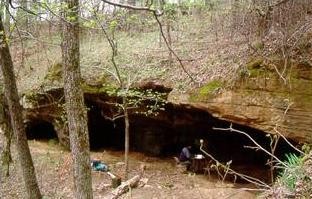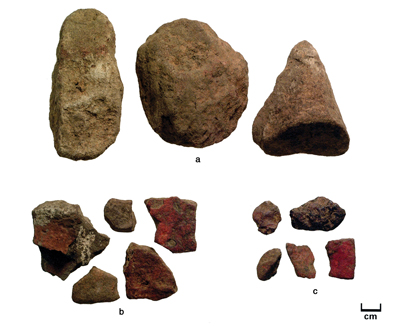Tools for Making Rock Art at The Narrows
By Deborah Sabo
The Arkansas Archeological Survey, during excavations at The Narrows rock shelter in 1995, made a very important discovery. For the first time at a site in Arkansas, undisturbed artifacts that could be independently dated were linked directly to the production of rock art on the walls of the rock shelter. This means that archeologists could place the making of the rock art in the same context with all the other activities carried out by people who lived at the site, and give it an accurate date, almost 600 years ago. The artifacts were found in a deposit archeologists call midden. Dark midden soils are rich in organic compounds left by the decomposing wood, plant fiber, hides, and other animal tissues that littered a domestic campsite or village. Midden also usually contains lots of small broken bits of artifacts such as pottery sherds and stone tool fragments, and larger organic remains (if they are preserved in the particular soil chemistry) such as broken animal bones, seeds, and shells left over from preparing and eating food. At The Narrows, the excavators realized the midden deposit was a trash dump, a place where the Indians living at the shelter had piled all the refuse they cleaned out of their hearths and living area. This trash dump contained samples that could be radiocarbon dated. Thus, we know that these activities took place around A.D. 1435. The date is also supported by pottery sherds of a style (“Poteau Plain”) that links the site to cultural groups of the Arkansas River Valley for which we already have similar dates. Analyzing all the artifacts and remains at The Narrows showed that people who stayed at the rock shelter spent their time on a few major activities. They hunted and gathered food to support themselves, but they were also preparing for the winter by collecting large amounts of hickory nuts and processing these into a storable product called hickory milk. Animal bones and turtle shells were smashed into tiny fragments, suggesting these also were being processed, probably for grease. This could have been for food. Nutritional needs for people who lived a physically demanding outdoor life were different from what our doctors prescribe today. People needed a high fat content in their diet, including animal fats, during the cold season, because their bodies needed to burn a lot of calories just to stay warm. Based on historical observations, we know this smashed bone evidence might indicate the people were extracting the high-fat bone marrow and bone grease to mix with other foods and pack away for the winter. At The Narrows, this makes good sense. We know people must have been living there during the fall because of all the hickory nutshells. These are only available in late fall. Apparently people came to the site on purpose to gather and prepare the nuts and other foods to prepare for winter. Another major activity at The Narrows was making siltstone hoes. Most of the chipped stone fragments at the site are siltstone rather than chert. This is unusual for an archeological site in the Ozarks. There are finished hoes at the site, but they probably were not used until the people moved down to the Arkansas or Mulberry river valleys to till their gardens in the growing season. So the family or families staying at The Narrows were using the winter days to make tools they would need for warm season agriculture. Perhaps they even made extras for trade. Last but not least, The Narrows people made rock art. Mixed in with the other midden finds were certain artifacts specifically related to the art images on the shelter walls. There were ground-stone abrading tools made from fire-cracked rocks, flat pieces of sandstone with red paint on them, and worn pieces of hematite and manganese. Each of these has a special significance.
The abrading tools were just pieces of rock that the Indians picked out of their fireplaces, of a size they could hold in their hands. They used these rocks to scrape and smooth the surface of the shelter walls, to prepare them for the rock art designs. Some of them may have been used to create the petroglyphs by pecking the designs onto the walls. The evidence of use is on the abrading stones in the form of striations and grinding. When the Indians were finished, they simply tossed the abraders into the trash heap. The flat pieces of sandstone with red paint are spalls that have fallen from the walls of the shelter, either by natural weathering and erosion or by the smoothing process just described. The red paint is the remains of earlier rock art. Hematite and manganese are minerals that were used for pigments. Hematite (red ocher) could sometimes be used as a “crayon” applied directly to the rock surface, and gives a red color. Manganese is too hard to do this. Both minerals could be heated and then ground to a powder that is mixed with some binding substance to make paint. Recall the smashed animal bones discussed above? Animal fat is one substance that was used as a binder for paint. The rock art at The Narrows consists of painted petroglyphs. The designs (mostly human figures) were first pecked onto the wall using a hard stone. Many were then filled in using black paint (manganese pigment), accented with red (hematite pigment). Archeologists have not been able to analyze any paint samples to see if animal fat or other substances were used as binders. The Narrows is one of a select few Arkansas rock art sites where scientific archeological excavations have been able to place the art in a cultural context. It is the only site in Arkansas where this allowed an independent date for creation of the art. We now know people were living at the site and doing day-to-day things when the art was made. This has tremendous implications for interpreting possible meanings of The Narrows rock art panels. |
| Home | Quick Facts | Interpretations | Articles | Technical Papers | Resources | Database | Just For Kids | Picture Gallery | Buy the Book! |
|
Last Updated: May 3, 2007 at 1:37:25 PM Central Time
|


